seats CITROEN C4 2019 Owners Manual
[x] Cancel search | Manufacturer: CITROEN, Model Year: 2019, Model line: C4, Model: CITROEN C4 2019Pages: 317, PDF Size: 9.31 MB
Page 4 of 317
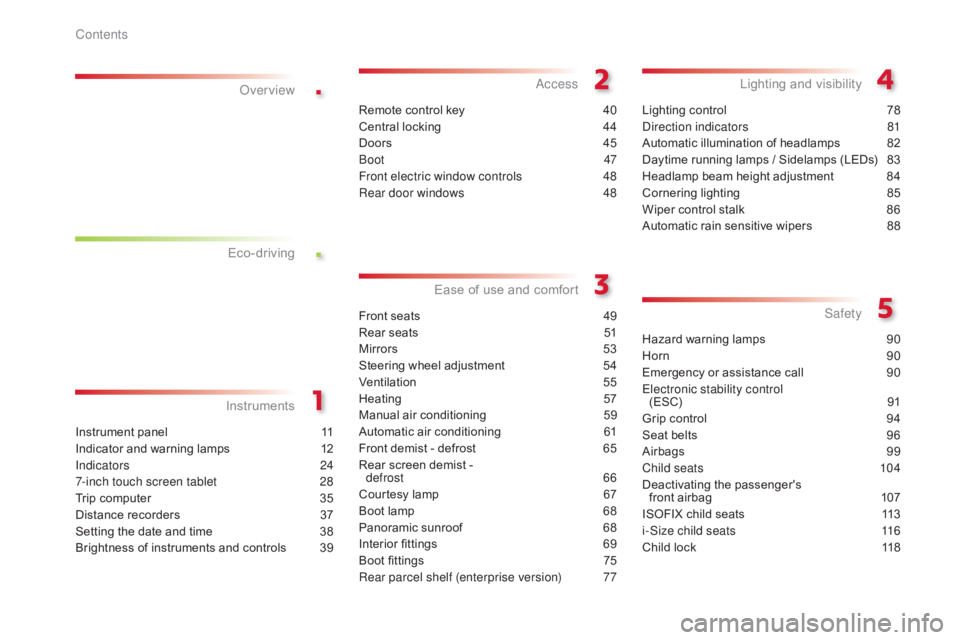
.
.
C4-cactus_en_Chap00a_sommaire_ed01-2016
Instrument panel 11
Indicator and warning lamps
1
2
Indicators
2
4
7-inch touch screen tablet
2
8
Trip
computer
3
5
Distance
recorders
3
7
Setting
the date and time
3
8
Brightness
of instruments and controls
3
9
InstrumentsOver view
Remote control key 4
0
Central locking
4
4
Doors
4
5
Boot
47
Front electric window controls
4
8
Rear door windows
4
8
Access
Front seats 49
Rear seats
5
1
Mirrors
5
3
Steering
wheel adjustment
5
4
Ventilation
5
5
Heating
5
7
Manual
a
ir
c
onditioning
5
9
Automatic
air conditioning
6
1
Front
demist - defrost
6
5
Rear
screen demist -
d
efrost 66
Courtesy
lamp
6
7
Boot
lamp
6
8
Panoramic
sunroof
6
8
Interior
fittings
6
9
Boot
fittings
7
5
Rear parcel shelf (enterprise version)
7
7
Ease of use a nd c omfort
Lighting control 7 8
Direction indicators
8
1
Automatic
illumination of headlamps
8
2
Daytime
running lamps / Sidelamps (LEDs)
8
3
Headlamp
beam height adjustment
8
4
Cornering
lighting
8
5
Wiper
control stalk
8
6
Automatic
rain sensitive wipers
8
8
Lighting and v isibility
Hazard warning lamps 9 0
Horn
9
0
Emergency
or assistance call
9
0
Electronic stability control (ESC)
9
1
Grip
control
9
4
Seat
belts
9
6
Airbags
9
9
Child seats
1
04
Deactivating
t
he
p
assenger's
f
ront airbag
1
07
ISOFIX
child seats
1
13
i-Size child seats
1
16
Child
lock
1
18
Safety
Eco-driving
Contents
Page 7 of 317
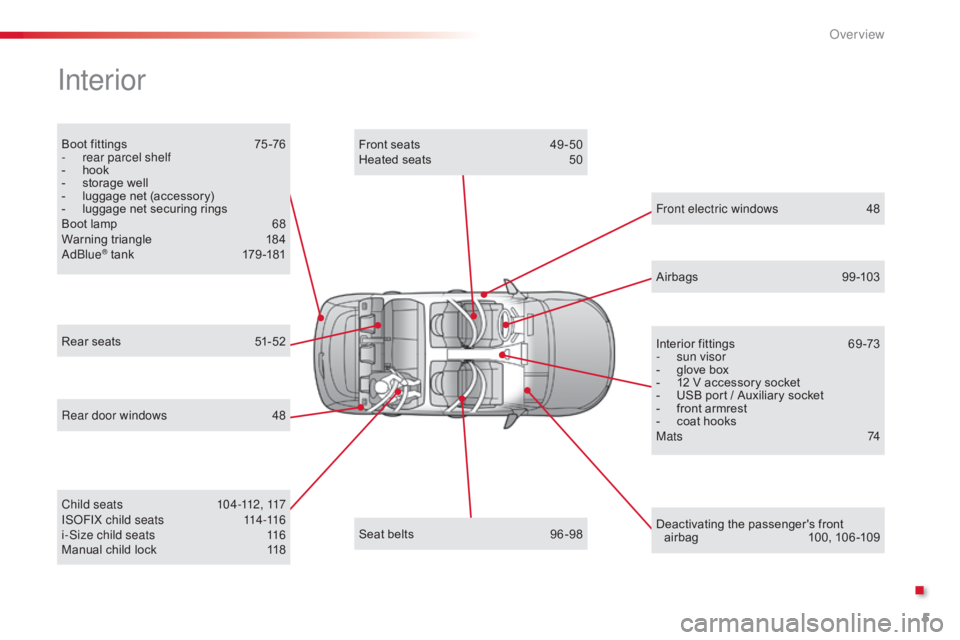
5
C4-cactus_en_Chap00b_vue-ensemble_ed01-2016
Boot fittings 75 -76
- r ear parcel shelf
-
h
ook
-
s
torage well
-
l
uggage net (accessory)
-
l
uggage net securing rings
Boot
lamp
6
8
Warning
triangle
1
84
AdBlue
® t a n k 17 9 -181
Interior
Rear door windows 4 8
Manual child lock
1
18
Rear
seats
5
1-52
Airbags
9
9-103
Front electric windows
4
8
Deactivating
t
he
p
assenger's
f
ront
a
irbag
10
0,
10
6 -109
Seat
belts
9
6 -98
Child seats
1
04-112, 117
ISOFIX child seats
1
14-116
i-Size child seats
1
16Front
seats
4
9 -50
Heated seats
5
0
Interior fittings
6
9 -73
-
s
un visor
-
g
love box
-
1
2 V accessory socket
-
U
SB port / Auxiliary socket
- f ront armrest
- c oat hooks
M a t s
74
.
Over view
Page 12 of 317
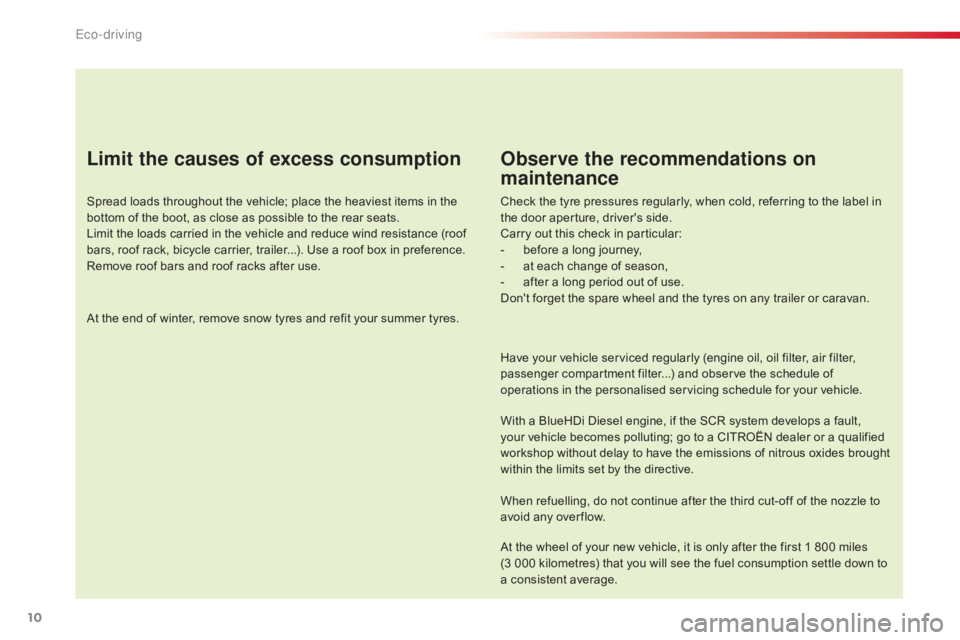
10
C4-cactus_en_Chap00c_eco-conduite_ed01-2016
Limit the causes of excess consumption
Spread loads throughout the vehicle; place the heaviest items in the bottom of the boot, as close as possible to the rear seats.
Limit
the loads carried in the vehicle and reduce wind resistance (roof
b
ars, roof rack, bicycle carrier, trailer...). Use a roof box in preference.
Remove
roof bars and roof racks after use.
At
the end of winter, remove snow tyres and refit your summer tyres.
Observe the recommendations on
maintenance
Check the tyre pressures regularly, when cold, referring to the label in the door aperture, driver's side.
Carry
out this check in particular:
-
b
efore a long journey,
-
a
t each change of season,
-
a
fter a long period out of use.
Don't
forget the spare wheel and the tyres on any trailer or caravan.
Have
your vehicle serviced regularly (engine oil, oil filter, air filter,
p
assenger compartment filter...) and observe the schedule of
o
perations in the personalised servicing schedule for your vehicle.
With
a BlueHDi Diesel engine, if the SCR system develops a fault,
y
our vehicle becomes polluting; go to a CITROËN dealer or a qualified
w
orkshop without delay to have the emissions of nitrous oxides brought
w
ithin the limits set by the directive.
When
refuelling, do not continue after the third cut-off of the nozzle to
a
void any over flow.
At
the wheel of your new vehicle, it is only after the first 1 800 miles
(3
000 kilometres) that you will see the fuel consumption settle down to
a
consistent average.
Eco-driving
Page 50 of 317
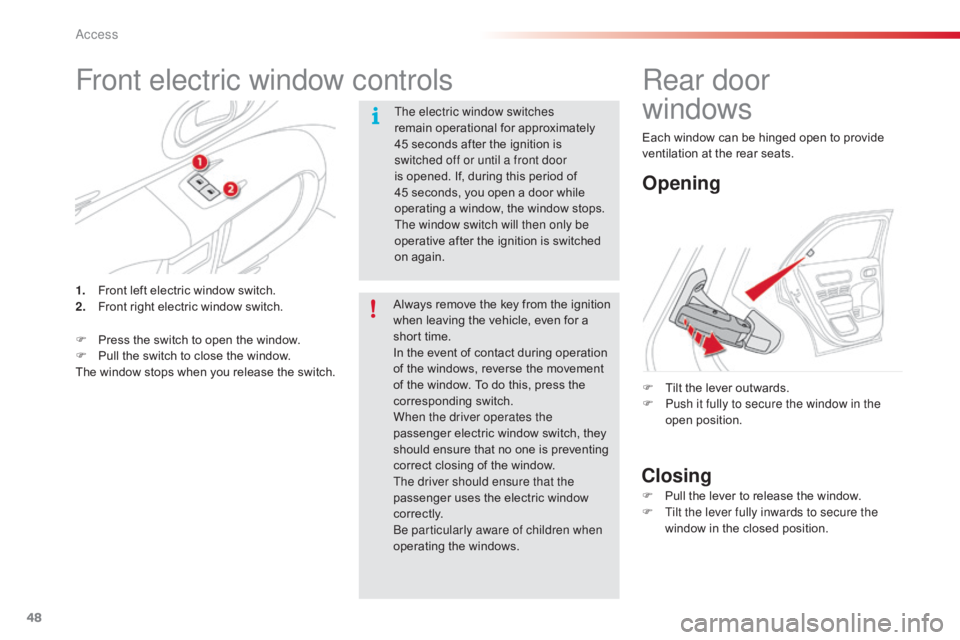
48
C4-cactus_en_Chap02_ouvertures_ed01-2016
Front electric window controls
The electric window switches
remain operational for approximately
4
5 seconds after the ignition is
s
witched off or until a front door
is
opened. If, during this period of
4
5 seconds, you open a door while
o
perating a window, the window stops.
T
he window switch will then only be
operative
after the ignition is switched
o
n again.
1.
F
ront
left
electric
window
switch.
2.
F
ront
right
electric
window
switch.
F
P
ress
the
switch
to
open
the
window.
F
P
ull
the
switch
to
close
the
window.
The
window
stops
when
you
release
the
switch. Always
remove the key from the ignition
w
hen leaving the vehicle, even for a
s
hort time.
In
the event of contact during operation
o
f the windows, reverse the movement
o
f the window. To do this, press the
c
orresponding
s
witch.
When the driver operates the
passenger
electric window switch, they
s
hould ensure that no one is preventing
c
orrect closing of the window.
The driver should ensure that the
passenger
uses the electric window
c
o r r e c t l y.
Be particularly aware of children when
operating
t
he
w
indows.
Rear door
windows
Opening
Closing
F Tilt the lever outwards.
F P ush it fully to secure the window in the
open
p
osition.
F
P
ull the lever to release the window.
F
T
ilt the lever fully inwards to secure the
window
in the closed position.
Each
window can be hinged open to provide
v
entilation at the rear seats.
Access
Page 51 of 317
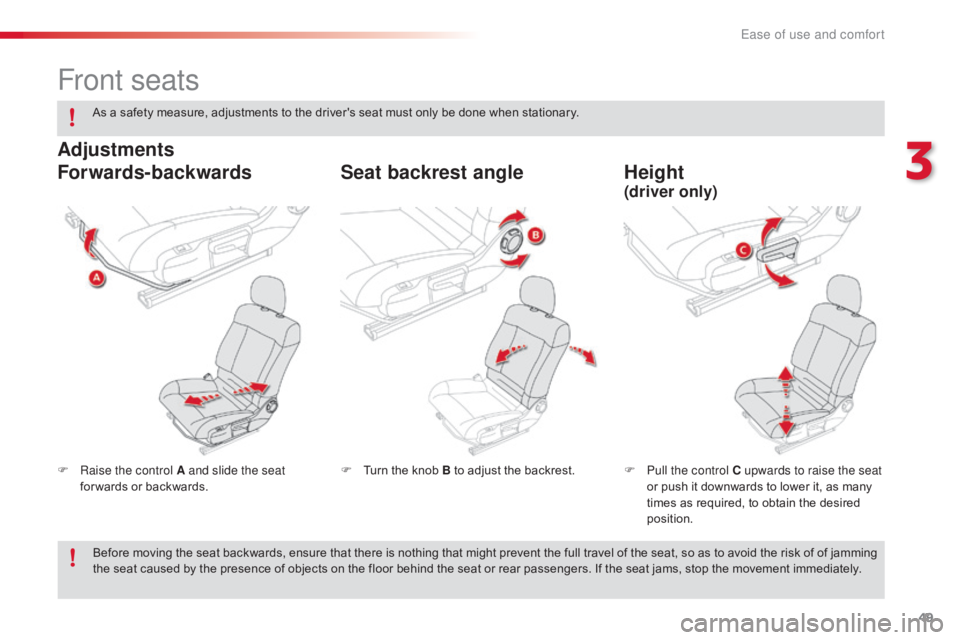
49
C4-cactus_en_Chap03_Ergonomie-et-confort_ed01-2016
Front seats
F Raise the control A and slide the seat for wards or backwards. F
P ull the control C upwards to raise the seat
or push it downwards to lower it, as many
t
imes as required, to obtain the desired
p
osition.
F
T urn the knob B to adjust the backrest.
Forwards-backwards
Height
Seat backrest angle
Adjustments
(driver only)
As a safety measure, adjustments to the driver's seat must only be done when stationary.
B efore moving the seat backwards, ensure that there is nothing that might prevent the full travel of the seat, so as to avoid the risk of of jamming
t
he seat caused by the presence of objects on the floor behind the seat or rear passengers. If the seat jams, stop the movement immediately.
3
Ease of use and comfort
Page 52 of 317
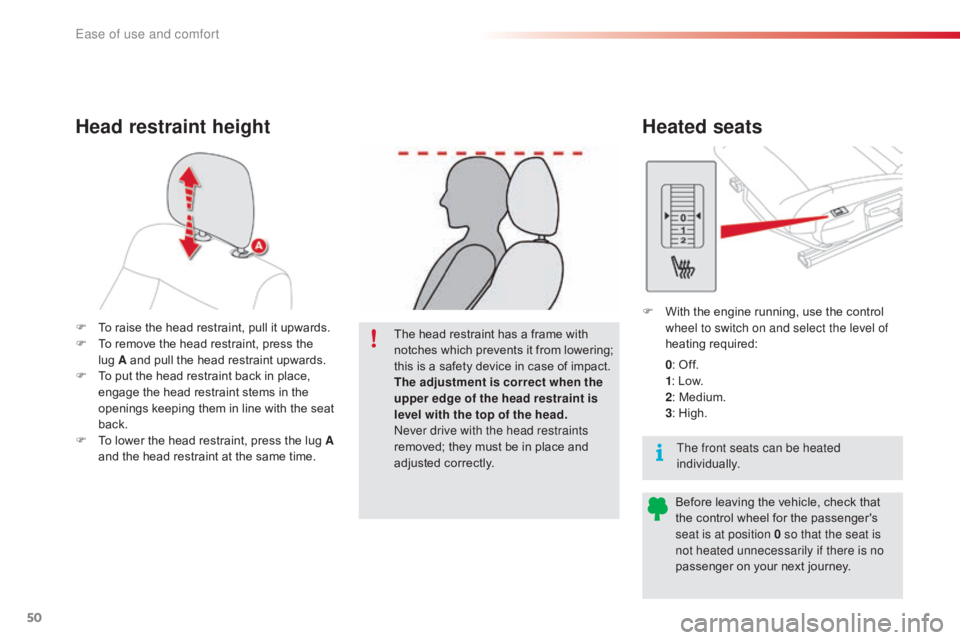
50
C4-cactus_en_Chap03_Ergonomie-et-confort_ed01-2016
F To raise the head restraint, pull it upwards.
F T o remove the head restraint, press the
lug
A and pull the head restraint upwards.
F
T
o put the head restraint back in place,
e
ngage the head restraint stems in the
o
penings keeping them in line with the seat
b
ack.
F
T
o lower the head restraint, press the lug A
and
the head restraint at the same time.The
head restraint has a frame with
n
otches
which
prevents
it
from
lowering;
t
his is a safety device in case of impact.
The adjustment is correct when the
upper edge of the head restraint is
level with the top of the head.
Never drive with the head restraints
removed;
they must be in place and
adj
usted
c
orrectly.
Head restraint heightHeated seats
F With the engine running, use the control w
heel to switch on and select the level of
heating
r
equired:
0 :
Off.
1 :
Low.
2 :
Medium.
3 :
High.
Before
leaving the vehicle, check that
t
he control wheel for the passenger's
s
eat is at position 0 so that the seat is
not heated unnecessarily if there is no
passenger
on your next journey.
The front seats can be heated
individually.
Ease of use and comfort
Page 53 of 317
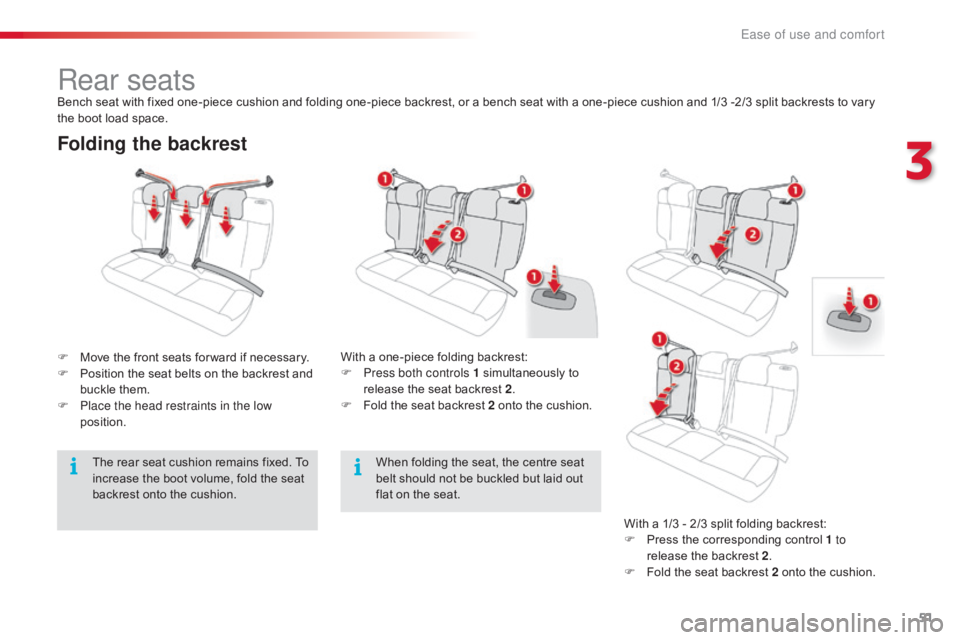
51
C4-cactus_en_Chap03_Ergonomie-et-confort_ed01-2016
Folding the backrest
F Move the front seats for ward if necessary.
F P osition the seat belts on the backrest and
b
uckle them.
F
P
lace the head restraints in the low
position. With
a one-piece folding backrest:
F P ress both controls 1 simultaneously to
r
elease the seat backrest 2.
F
F
old the seat backrest 2 onto the cushion.
Rear seatsBench seat with fixed one-piece cushion and folding one-piece backrest, or a bench seat with a one-piece cushion and 1/3 -2/3 split backrests to vary the boot load space.
When
folding the seat, the centre seat
b
elt should not be buckled but laid out
f
lat on the seat.With
a 1/3 - 2/3 split folding backrest:
F
P
ress the corresponding control 1 to
release
the backrest 2.
F
F
old the seat backrest 2 onto the cushion.
The
rear seat cushion remains fixed. To
i
ncrease the boot volume, fold the seat
b
ackrest onto the cushion.
3
Ease of use and comfort
Page 78 of 317
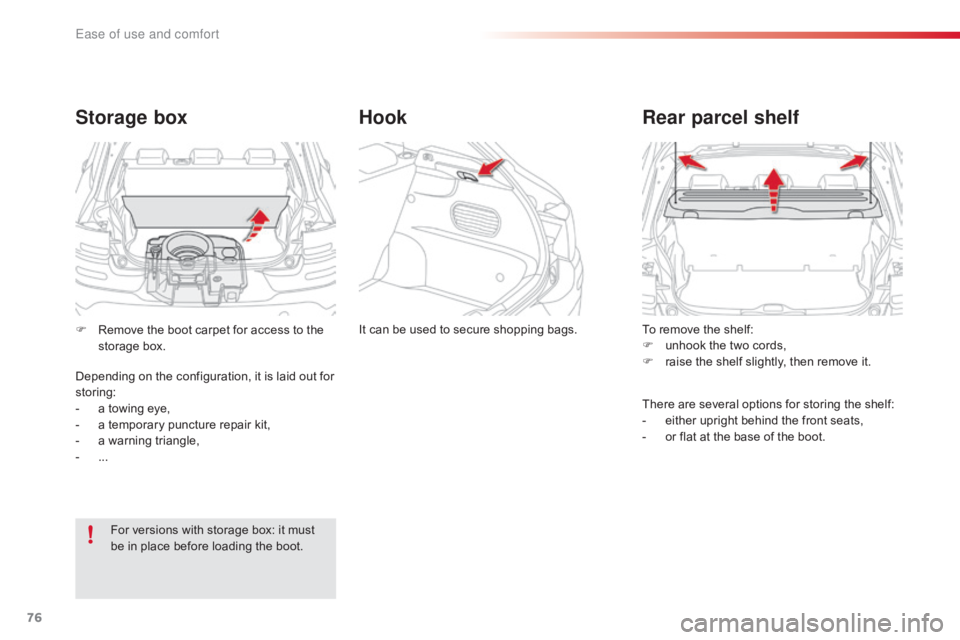
76
C4-cactus_en_Chap03_Ergonomie-et-confort_ed01-2016
To remove the shelf:
F u nhook the two cords,
F
r
aise the shelf slightly, then remove it.
Rear parcel shelf
There are several options for storing the shelf:
- e ither upright behind the front seats,
-
o
r flat at the base of the boot.
It
can
be
used
to
secure
shopping
bags.
Hook
Storage box
For versions with storage box: it must b
e in place before loading the boot.
F
R
emove the boot carpet for access to the
s
torage box.
Depending on the configuration, it is laid out for
s
toring:
-
a
towing eye,
-
a
temporary puncture repair kit,
-
a
warning triangle,
-
...
Ease of use and comfort
Page 98 of 317
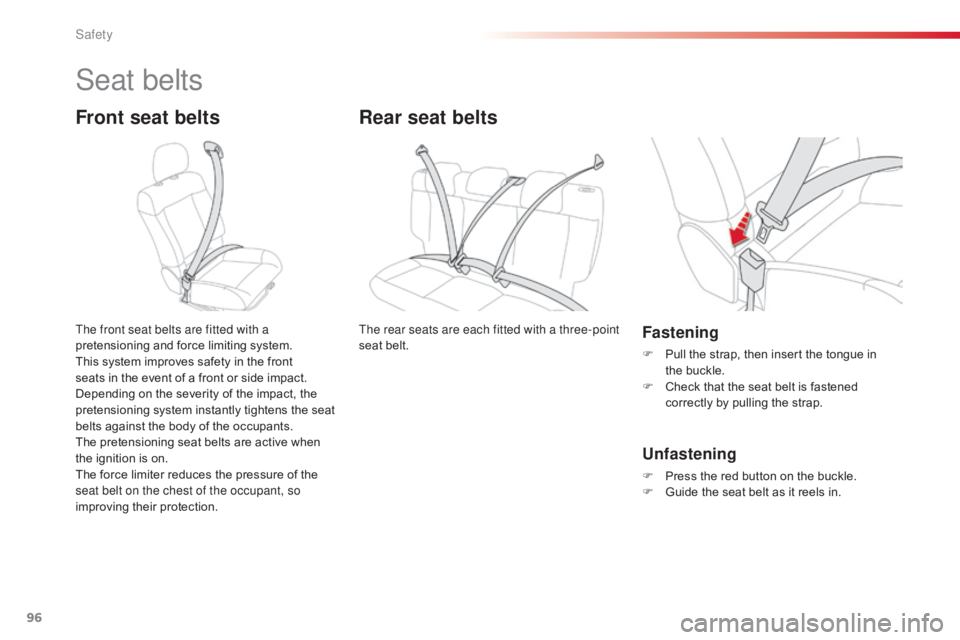
96
C4-cactus_en_Chap05_securite_ed01-2016
Seat belts
Front seat belts
The front seat belts are fitted with a
pretensioning and force limiting system.
This
system improves safety in the front
s
eats in the event of a front or side impact.
D
epending on the severity of the impact, the
p
retensioning system instantly tightens the seat
b
elts against the body of the occupants.
The
pretensioning seat belts are active when
t
he ignition is on.
The
force limiter reduces the pressure of the
s
eat belt on the chest of the occupant, so
improving
their protection.Fastening
F Pull the strap, then insert the tongue in t
he buckle.
F
C
heck that the seat belt is fastened
c
orrectly by pulling the strap.
Unfastening
F Press the red button on the buckle.
F G uide the seat belt as it reels in.
Rear seat belts
The rear seats are each fitted with a three-point
seat belt.
Safety
Page 100 of 317
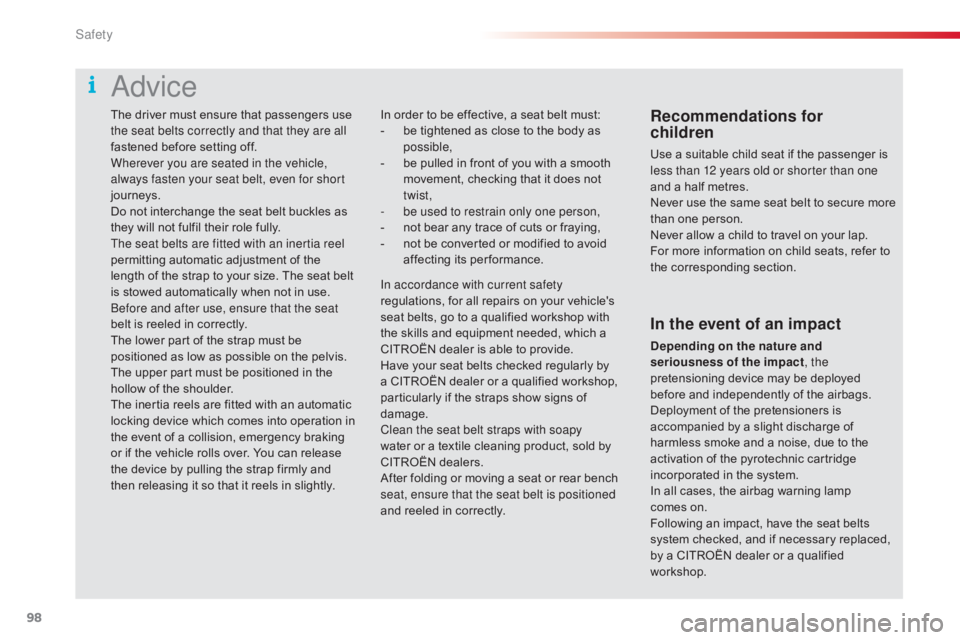
98
C4-cactus_en_Chap05_securite_ed01-2016
The driver must ensure that passengers use the seat belts correctly and that they are all
fastened
before setting off.
Wherever you are seated in the vehicle,
always fasten your seat belt, even for short
journeys.
Do
not interchange the seat belt buckles as
t
hey will not fulfil their role fully.
The seat belts are fitted with an inertia reel
permitting
automatic adjustment of the
l
ength of the strap to your size. The seat belt
i
s stowed automatically when not in use.
Before and after use, ensure that the seat
belt
is reeled in correctly.
The
lower part of the strap must be
p
ositioned as low as possible on the pelvis.
The
upper part must be positioned in the
h
ollow of the shoulder.
The
inertia reels are fitted with an automatic
l
ocking device which comes into operation in
t
he event of a collision, emergency braking
o
r if the vehicle rolls over. You can release
t
he device by pulling the strap firmly and
t
hen releasing it so that it reels in slightly.Recommendations for
children
Use a suitable child seat if the passenger is less than 12 years old or shorter than one
and
a half metres.
Never
use the same seat belt to secure more
t
han one person.
Never
allow a child to travel on your lap.
For
more information on child seats, refer to
t
he corresponding section.
In
order
to
be
effective,
a
seat
belt
must:
-
b
e
tightened
as
close
to
the
body
as
p
ossible,
-
b
e
pulled
in
front
of
you
with
a
smooth
m
ovement,
checking
that
it
does
not
t
wist,
-
b
e used to restrain only one person,
-
n
ot
bear
any
trace
of
cuts
or
fraying,
-
n
ot
be
converted
or
modified
to
avoid
a
ffecting
it
s
p
erformance.
In the event of an impact
Depending on the nature and
seriousness of the impact , the
pretensioning
device may be deployed
b
efore and independently of the airbags.
D
eployment of the pretensioners is
a
ccompanied by a slight discharge of
h
armless smoke and a noise, due to the
a
ctivation of the pyrotechnic cartridge
i
ncorporated in the system.
In
all cases, the airbag warning lamp
comes
on.
Following
an impact, have the seat belts
s
ystem checked, and if necessary replaced,
b
y a CITROËN dealer or a qualified
w
orkshop.
In accordance with current safety
regulations,
for
all
repairs
on
your
vehicle's
s
eat
belts,
go
to
a
qualified
workshop
with
t
he
skills
and
equipment
needed,
which
a
C
ITROËN
dealer
is
able
to
provide.
Have
your
seat
belts
checked
regularly
by
a
CITROËN
dealer
or
a
qualified
workshop,
p
articularly
if
the
straps
show
signs
of
d
amage.
Clean the seat belt straps with soapy
water
or
a
textile
cleaning
product,
sold
by
C
ITROËN
dealers.
After
folding
or
moving
a
seat
or
rear
bench
s
eat, ensure that the seat belt is positioned
and
reeled
in
correctly.
Advice
Safety